Captain Stephen Smith
1757 ( 1752) or 1786 according to his obituary in the SF newspaper – 1855
Smith’s background
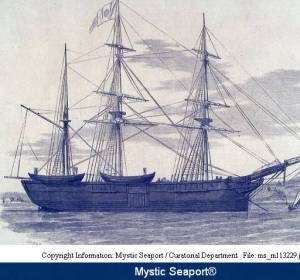 Smith was born December 15th in Dartmouth, Massachusetts, the oldest son of 5 children born to Giles Smith and Ruth Howland. He seems to have married three times and also had native American housekeepers with whom he had children.
Smith was born December 15th in Dartmouth, Massachusetts, the oldest son of 5 children born to Giles Smith and Ruth Howland. He seems to have married three times and also had native American housekeepers with whom he had children.
His ship was the George Henry[i] and he sailed out of Baltimore, Maryland for several years trading his cargo of sugar, syrup, tobacco and cloth for hides,horns and tallow. In 1841 he came to California for the first time, sailing around Cape Horn and stopping in Piura, a port in Peru[ii]. On board ship was Manuela Torres, a lady of ‘intelligence and refinement.’ She was traveling with her mother and brother. The fact that Smith was 61 and Manuela was only 16 seems to have been no impairment to their union and they were married. Since he took a wife with him to California this strongly indicates that he intended to give up his itinerant life of sailing the seas and settle down. On board he had a square piano situated in the cabin since Manuela was an accomplished pianist.
Smith and Abrego
His first port of call in California was Monterey where he visited Don Jose Abrego, a prominent merchant and former Mexican hatter who had come to Monterey in 1834 and who held many offices including the administrator of San Antonio Mission and custom house officer, eventually becoming treasurer of the province from 1839 to 1846. Born in Mexico City on March 3, 1813, Don Jose Abrego ran a billiards parlor in Monterey in 1848 and was president of an association which operated a quick silver mine. When California became a state in 1850, he was an official of both the Mexican and Yankee governments. In 1862 he established a soap factory in Monterey and was active in local affairs until his death in April 1878. His historic adobe is preserved there. Don Abrego was highly taken with the piano and asked Smith to bring a piano for him to purchase when he next came to visit, suggesting that a piano would better serve as a source of dance music than the violins and guitars then in use. Smith ventured north and saw the tall redwoods covering the coastal slopes of the Santa Cruz mountains and further north along the Sonoma coast. Up until this point lumber for building had been shipped to the mainland from as far away as the Sandwich Islands (Hawaii) and Smith was quick to recognize the potential of a source of redwood lumber less than 100 nautical miles from the new village of Yerba Buena (San Francisco) which seemed to promise much growth. The level land of the Sonoma coast appeared to offer prospects of wealth for Smith through the cultivation of arable land. Thus Smith envisaged trading for much more than tallow and hides. If he could grind wheat into flour, and cut redwood into serviceable planks for new construction his reputation as a land baron would be established. Of course all this would be dependent of his ability to obtain a land grant. From Sonoma County Historical Society :
| Mexican Land Grants in Sonoma County |
| # | Square leagues granted by Mexico |
Acres confirmed by US |
Grantee | DateApproved | |
| 01 | German | 5 | 17,580 | Ernesto Rufus | 06/1846 |
| 02 | Muniz | 4 | 17,761 | Manuel Torres | 03/1846 |
| 03 | Bodega | 8 | 35,488 | Esteban Smith | 04/1846 |
| 04 | Estero Americano | 2 | 8,849 | E. Manuel McIntosh | 05/1840 |
In March 1843, Smith, keeping his promise to Don Jose, returned with three pianos and a disassembled saw mill and a grist mill from Boston. During the course of this journey around Cape Horn from the east coast he hand picked men to help him in his dream. From Baltimore, his port of departure, he employed Henry Hagler, a carpenter; at Valparaiso he picked up David D. Button, millwright; at Payta, Peru’s leading seaport, where he had found the future Mrs. Smith (Manuela Torres) he found William A. Streeter, an engineer. At other ports enroute he secured the services of Phillip Crawley and John Briggs, useful men for his colony.[iii] He arrived in Monterey in April, 1843, and delivered a piano to Don Jose Abrego at the price of $600. Abrego’s adobe house and gardens, built in the 1830’s are still extant in Monterey. I visited them in 2012.
Smith sets up operations in Bodega
At Santa Cruz he took on shipped lumber for the building of his mills. At San Francisco he shipped James Hudspeth, well known in this county, Nathaniel Coombs, now of Napa, John Daubenbiss, who later built a saw mill and a grist mill in Soquel, Santa Cruz county, and Alexander Copeland. By September Smith and his crew had reached Bodega, the goal of his venture. The land there, however, was owned by John Sutter. Sutter had been granted this land as part of his claim to the former Russian estate of Fort Ross. Sutter’s land agent, John Bidwell, notified Smith to ‘get himself, goods and chattels’ back to the ship and threatened him with the wrath of the Mexican government. But the government had never recognized the Russian claim and therefore was not interested in helping Sutter and Bidwell eject Smith. Governor Manuel Micheltorena granted Rancho Bodega, in part of the southern half of the former Russian claim, to Smith in 1844,[iv] and Governor Pio Pico granted Rancho Muniz (17,000 acres) including Ocean and Saltpoint townships in the northern half of the former Russian claim to Manuel Torres on Sept 14, 1844. Shortly after Smith was granted 8 leagues of land (35,000 acres) and Sutter left him in peace.
Smith lost no time in setting his men to work, assembling the steam flour and saw mills (the first steam engine of any sort in California, according to Bancroft) one mile north west of the village (called the Corners), on lmon Creek, strategically situated at the foot of a range of hills covered in dense redwood trees so that the logs could simply be rolled down the hill. To celebrate the completion of the newly constructed mills Smith organized a grand picnic, the first of Bodega’s celebrated picnics. Everyone in the vicinity was invited to witness the new wheat crop being sent between the steam powered grinding stones producing soft white flour which was quickly turned into newly baked bread in a big oven. As they were eating the bread and the beef barbequed in the fire pits the lumber mill was thrown into gear and the sash saw turned out the first boards which were then used as picnic tables. General Vallejo proposed a toast with a glass of fresh Sonoma wine. General Vallejo, then military commandant of California, was present, and says he predicted that before many years there would be more steam engines then soldiers in California. Captain Smith raised the American flag at Bodega in 1846 according to some sources just one day after it was raised in Sonoma, bringing to an end the short-lived Bear Flag Republic.
Captain Smith owned a small vessel called the Fayaway, which he sailed between the Port of Bodega and San Francisco; in 1849, fare was $14 from Bodega to San Francisco.
Soon Bodega Bay became famous as a port for the shipment of lumber, flour, grain and dairy products. The plant operated until 1850 drawing redwood from up to 6 miles away from Bodega bay supplying these goods to entire West coast and exporting them to Hawaii. In 1850 Smith leased the entire tract of land to Mr Hanks and Mr Mudge for the sum of $50,000. In 1854 the mill was destroyed by fire. In 1857 Smith was granted more land (22,000 acres) in exchange for lumber encompassing the Blucher Rancho in Analy township, making him one of the great land barons of California. In 1880 remains of the mill could still be found, overgrown by willows and there were still logs amidst the vegetation that had been collected but had never been dissected by the sash saw.
Captain Stephen Smith died on Nov 16, 1855, aged 68 years, and was buried in Lone Mountain cemetery, San Franciscoco.
What do we know about Smith as a person? He married three times and also fathered children with several young native American women who he took as housekeepers, one of whom was Tsupu who was born around 1830 in Petaluma. On March 5, 1843 he married Manuela Torres in Peru and they had three children, Manuela, born 1846, James, born 1847 and Stephen born 1848. If he married her in 1843 in Peru then it seems unlikely that she was on board the ship that Smith traveled to California on in 1841.
Smith at Rancho Bodega
I had discovered that Mark D. Selverston from Sonoma State University had done his Master’s degree research project on the Vasili Khlebnikov Ranch ‘situated closest to the port (Campbell Cove), north of a prominent waterway labeled on Duflot de Mofras’s map as the San Ignacio or Avatcha’. This ranch was the first to be developed by the Russian-American Company who had been exploring the North Pacific, supplying Alaskan Natives to hunt otter and Boston Traders supplied their ships[v]. In 1809 the company returned to Bodega Bay with plans to establish a permanent settlement. Three were set up, the closest to the port being Vasili Khlebnikov Ranch . ‘By 1839 there were 12 Russians, 3 Creoles, 2 Aleuts and 18 Native Californians (Miwok or Pomo) all residing at the ranch.’ The main house was an adobe measuring, according to Duflot de Mofras, 21 ft by 15 ft. There were other buildings made of wood. In August 1841 Helene de Rotchev (the wife of the commander of the Russian post at Fort Ross) celebrated her birthday in the pleasant meadows surrounding the ranch.[vi] By 1842 the Russian-American company had put up the entire California colony for sale and had left Alta California. John Sutter purchased the property and removed livestock and other merchandise but was instructed to leave the structure intact in case he defaulted on his payment. Although numerous people petitioned the Mexican government for the land and ranches left vacant by the Russians it was awarded to Captain Stephen Smith and named Bodega Rancho. [vii] Docking his ship in the new harbor at Bodega Smith most likely set up home in the building abandoned by the Russians, the only adobe constructed building known to have been built by Russians, obviously with the expertise of local Mexicans and Native peoples. However, when General William T. Sherman visited the site in 1848 he noted that Smith ‘employed a number of absolutely naked Indians in making adobes.’ [viii] Were they building an addition? Three years later Steven Fowler arrived in Bodega and was hired by Smith to do the fine carpentry on his newly built adobe that measured 70’ x 27.’[ix] So,
Selverston poses the question ‘How can Smith’s 70’ x 30’ adobe also be the Russian’s 21’ x 15’ adobe?
My visit to the site
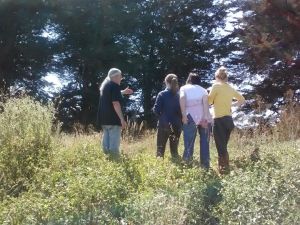 In the Summer of 2012 Fort Ross was holding a bicentennial weekend and my daughters and I decided to go and also go to Bodega. Selverston put me in contact with the current owner of the property where the adobe is located and Michael Costello invited us to meet him and view the site. Michael turned out to have a wealth of knowledge. He had purchased the property in the 1960’s because of its historical connections: he was a great history buff. He owns artifacts that were discovered in Mark’s dig. Michael’s own house was built in 1906 in Santa Ana and was moved piece by piece up to Bodega. It took him 30 years to rebuild the two storey house. The archaeological dig was carried out around 2000. There was a bakery and a kitchen adjoined the adobe out back. When the adobe burned down in 1892 the fire worked like a kiln and so the ricks were intact and decipherable. Smith left the adobe for San Francisco 25 years before the fire, making it 1867. Many settlers came to Smith for supplies. Logs were hard to come by at that time. Outside the native American hogans, which bordered the adobe, were circles of oyster shells since the door openings rotated with the seasons. We spent over an hour chatting with Michael in the bright sun. He suggested that the old piano currently in the Potter schoolhouse in Bodega could have come from Smith’s adobe, though I have been unable to find information about this. The schoolhouse, famous for its role in Hitchcock’s ‘The Birds’, is privately owned, and Bodega historical society seem to be unreachable by phone though I did find 2 articles about Smith written by Robin Rudderow, the society’s archivist, giving some information, though without sources. The children Smith had with his Miwok wife remained in Bodega and Smith Brothers Road is named after them. There are two websites made by descendants of Smith who live in the area. Manuela, Smith’s Peruvian wife who he married on the voyage, gave $200 to start the Catholic church in Bodega. According to Robin Rudderow, the Rancho Bodega Historical Society archivist the Smiths ‘lived in the old church built by the Russians in Saint Helena until 1851 when their own large adobe home was built. He found that the conditions in the old Russian church were not good for the piano, so he sold it to General Mariano Vallejo.’[x] The Smiths left the adobe and moved to San Francisco. There is a diary in the Bancroft library of two brothers who did the woodworking at the adobe and also panned for gold. Presumably these are the Fowlers. Mark copied it and Michael has been transcribing it for publication in the local Navigator newspaper. Honoria Tuomey was a key historical figure in the history of western Sonoma county and published two volumes of its history in 1926.
In the Summer of 2012 Fort Ross was holding a bicentennial weekend and my daughters and I decided to go and also go to Bodega. Selverston put me in contact with the current owner of the property where the adobe is located and Michael Costello invited us to meet him and view the site. Michael turned out to have a wealth of knowledge. He had purchased the property in the 1960’s because of its historical connections: he was a great history buff. He owns artifacts that were discovered in Mark’s dig. Michael’s own house was built in 1906 in Santa Ana and was moved piece by piece up to Bodega. It took him 30 years to rebuild the two storey house. The archaeological dig was carried out around 2000. There was a bakery and a kitchen adjoined the adobe out back. When the adobe burned down in 1892 the fire worked like a kiln and so the ricks were intact and decipherable. Smith left the adobe for San Francisco 25 years before the fire, making it 1867. Many settlers came to Smith for supplies. Logs were hard to come by at that time. Outside the native American hogans, which bordered the adobe, were circles of oyster shells since the door openings rotated with the seasons. We spent over an hour chatting with Michael in the bright sun. He suggested that the old piano currently in the Potter schoolhouse in Bodega could have come from Smith’s adobe, though I have been unable to find information about this. The schoolhouse, famous for its role in Hitchcock’s ‘The Birds’, is privately owned, and Bodega historical society seem to be unreachable by phone though I did find 2 articles about Smith written by Robin Rudderow, the society’s archivist, giving some information, though without sources. The children Smith had with his Miwok wife remained in Bodega and Smith Brothers Road is named after them. There are two websites made by descendants of Smith who live in the area. Manuela, Smith’s Peruvian wife who he married on the voyage, gave $200 to start the Catholic church in Bodega. According to Robin Rudderow, the Rancho Bodega Historical Society archivist the Smiths ‘lived in the old church built by the Russians in Saint Helena until 1851 when their own large adobe home was built. He found that the conditions in the old Russian church were not good for the piano, so he sold it to General Mariano Vallejo.’[x] The Smiths left the adobe and moved to San Francisco. There is a diary in the Bancroft library of two brothers who did the woodworking at the adobe and also panned for gold. Presumably these are the Fowlers. Mark copied it and Michael has been transcribing it for publication in the local Navigator newspaper. Honoria Tuomey was a key historical figure in the history of western Sonoma county and published two volumes of its history in 1926.
Honoria Tuomey,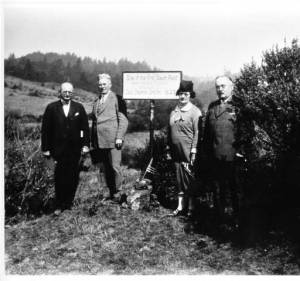 a historian, fervently believed that the adobe melt on Michael’s property was Smith’s house and she placed a sign at the Tannery but there’s nothing left of it today. She also asked for Smith’s doorplate(which she had placed there) to be placed in her casket when she died at the Napa Asylum in 1938. Born in 1866 on the Buckhorn ranch on Coleman Valley road (now known as Franceschi ranch) she attended the Potter school in Bodega, taught art and vocal music in Sebastopol high school and retired through ill health devoting the rest of her life to the history surrounding her. In her book she writes of the Donner party survivors who settled on Spring Hill just west of Sebastopol. Sonoma County wasjust 75 years old when Tuomey was writing her history. She knew the daughters of General Vallejo personally, and was best remembered for her historical markers which included one on the adobe house of Captain Smith. Information about Tuomey was gleaned from an article in the Press Democrat, 1990 by Gaye LeBarron. I spoke with her and was told that Jenny Morgan of Tomales History Center has the two volume book and disc. LeBarron got some of her information from Ruth Burke, Bodega’s historian in 1990, and Tuomey’s student at Potter school, who died recently (2012). She was the daughter of the store keeper in Bodega (Howard McCally) and Burke’s notes were still in boxes there. The land on the other side of Salmon Creek was owned by a Scot.
a historian, fervently believed that the adobe melt on Michael’s property was Smith’s house and she placed a sign at the Tannery but there’s nothing left of it today. She also asked for Smith’s doorplate(which she had placed there) to be placed in her casket when she died at the Napa Asylum in 1938. Born in 1866 on the Buckhorn ranch on Coleman Valley road (now known as Franceschi ranch) she attended the Potter school in Bodega, taught art and vocal music in Sebastopol high school and retired through ill health devoting the rest of her life to the history surrounding her. In her book she writes of the Donner party survivors who settled on Spring Hill just west of Sebastopol. Sonoma County wasjust 75 years old when Tuomey was writing her history. She knew the daughters of General Vallejo personally, and was best remembered for her historical markers which included one on the adobe house of Captain Smith. Information about Tuomey was gleaned from an article in the Press Democrat, 1990 by Gaye LeBarron. I spoke with her and was told that Jenny Morgan of Tomales History Center has the two volume book and disc. LeBarron got some of her information from Ruth Burke, Bodega’s historian in 1990, and Tuomey’s student at Potter school, who died recently (2012). She was the daughter of the store keeper in Bodega (Howard McCally) and Burke’s notes were still in boxes there. The land on the other side of Salmon Creek was owned by a Scot.
After Smith died Manuela married Tyler Curtis who wanted to eject all the settlers whom Smith had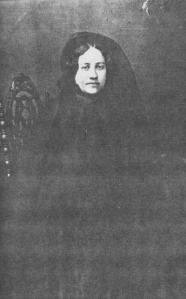 welcomed creating the ‘Tyler Curtis war.’ Manuela died in San Francisco on February 25, 1871 at the age of 43. The Petaluma newspaper carried the following article on May 2, 1873 that told the last chapter of Manuela and Tyler Curtis’ story: “Tyler Curtis, formerly a resident of Bodega and latterly a prominent capitalist and politician of San Francisco, left that city a day or
welcomed creating the ‘Tyler Curtis war.’ Manuela died in San Francisco on February 25, 1871 at the age of 43. The Petaluma newspaper carried the following article on May 2, 1873 that told the last chapter of Manuela and Tyler Curtis’ story: “Tyler Curtis, formerly a resident of Bodega and latterly a prominent capitalist and politician of San Francisco, left that city a day or two ago in a clandestine manner, leaving behind him unsettled debts and unexplained transactions of a much darker character. He is charged with seducing a young lady under promise of marriage; forgeries for a considerable amount; and defrauding his stepchildren out of their inheritance. “Some 17 years ago, Mr. Curtis married a Peruvian lady. When Mrs. Curtis died a few years ago, she left the whole of her property to Mr. Curtis by will, to the exclusion of her children. One of her sons states that it is his intention to exhume the body of Mrs. Curtis and have it submitted to analytical chemists.” According to Michael there used to be 2 grave sites on Salmon Creek road one of which was incorrectly marked. The land on the other side of Salmon Creek was owned by a Scot. I found a photo of this in Honoria’s book at the San Jose State library July 31st, 2012.
two ago in a clandestine manner, leaving behind him unsettled debts and unexplained transactions of a much darker character. He is charged with seducing a young lady under promise of marriage; forgeries for a considerable amount; and defrauding his stepchildren out of their inheritance. “Some 17 years ago, Mr. Curtis married a Peruvian lady. When Mrs. Curtis died a few years ago, she left the whole of her property to Mr. Curtis by will, to the exclusion of her children. One of her sons states that it is his intention to exhume the body of Mrs. Curtis and have it submitted to analytical chemists.” According to Michael there used to be 2 grave sites on Salmon Creek road one of which was incorrectly marked. The land on the other side of Salmon Creek was owned by a Scot. I found a photo of this in Honoria’s book at the San Jose State library July 31st, 2012.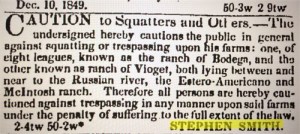
Michael told us that the site of the saw mill was due north of his ranch and it was possible that we could find it. He’d been there once, but I’m not sure if he found it. We bravely set out through a field where the grass was waist deep, heading for the trees which showed the location of the creek. Undeterred bythe barbed wire I found an opening and, much to the girls’ concern, headed into the dense undergrowth. Eventually they followed me and we found that walking along the stream bed was easier than getting through the bushes. Although we saw a few large rocks which looked as if they could have been put there purposely and a thick tree trunk that had been sawn we didn’t find any remnants of the first steam powered sawmill in California, that had come on the ship with the three pianos from the East coast in 1843. This photograph, taken in 1925 shows Charles Gallagher, Rolph Thompson, Honoria Tuomey and Herbert Slater presumably at the dedication of the plaque and reads ‘Site of the First Steam Plant,’ 1843.
One thing we did find, though, was an article in a travel magazine about Stephen Smith and there was a drawing of him. I contacted the magazine to find out where they got the photo from but they didn’t know. In Honoria’s book I found the same picture.
The one in the picture is the bark built in 1841, as confirmed by American Whaling Voyages (attached below)[xi]. However, as you can see from her attachment, she didn’t start whaling until 1855, which means in ’43 she could have been carting pianos around. I found the reference in Bancroft that says the piano carrying George Henry was of 344 tons. However, tonnage of ships do change slightly over time, so that means both of the ships in our 1858 register are still in the running. It also means that there is a George Henry of 344 tons which was wrecked or otherwise out of service by 1858.At this point, I think you might need to contact Mystic or Mariner’s as they might have archival records which could help clear up this mystery. What we need is a register from 1843 so we can see if there is a listing for a third George Henry of 344 tons. I’m sorry if I have only muddied the waters here! Thanks, Gina Bardi, Reference Librarian, San Francisco Maritime National Historical Park.
[i] Though possibly the George and Henry. This engraving is the George Henry built 1841, Waldoboro, Maine, lost in the Hudson Bay 1863. Capt. James M. Buddington, 1855. Sidney O. Buddington in 1860. The engraving is signed Osborn ‘The bark ‘George Henry’ captain Sydney O. Buddington of New London which started for the Arctic regions on Tuesday May 28, 1860.’ (Info from Mystic Seaport)
[ii] Pasadena News Star, Nov 11, 1922
[iii] Ancestry.com has him bringing Hoepner too
[iv] Wikipedia
[v] Annie Ogden 1941:45, The California Sea Otter Trade, 1784-1848, University of California Press, Berkeley.
[vi] Mofras1937:13.
[vii] Trussell 1960:25
[viii] Sherman 1945:36
[ix] Fowler and Fowler 1916:193
http://greg-sarris.com/wp-content/uploads/2013/04/Declaration-of-Tooch-Colombo-signed.pdf
http://marklinares.com/history/
http://northbaydigital.sonoma.edu/cdm/singleitem/collection/Lebaron/id/429/rec/2
[x] Rancho Bodega Historical Society Newsletter, Oct 10, 2013
[xi] http://nmdl.org/aowv/whvessel.cfm?alpha=G
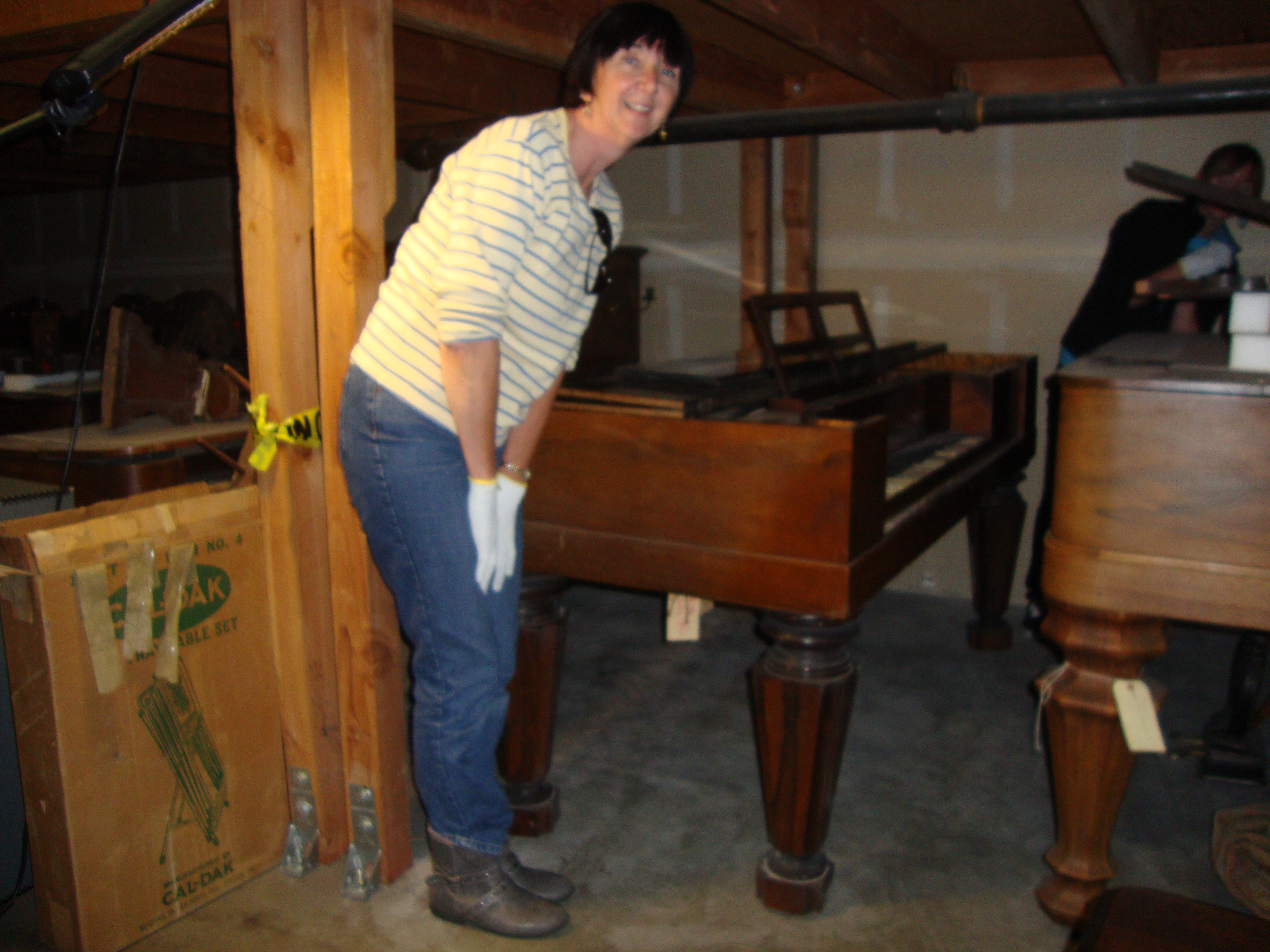
Recent Comments